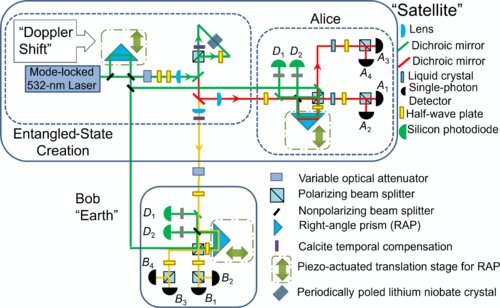Satellites may enable better quantum networks
by Matt Lakin, Oak Ridge National Laboratory

The BBM92 and HEQKD optical setup: photonic “ququarts” hyperentangled in polarization and time bin are generated via spontaneous parametric down-conversion in periodically poled lithium niobate (PPLN). The green lines are the 532-nm pump (and stabilization) beam, while the red and yellow lines are the signal (810-nm) and idler (1550-nm) photons, respectively. For BBM92, the pump right-angle prism is blocked so there is no time-bin entanglement. Credit: Physical Review Applied (2022). DOI: 10.1103/PhysRevApplied.18.044027
A study by Oak Ridge National Laboratory researchers has demonstrated how satellites could enable more efficient, secure quantum networks.
"We used experiment, emulation and simulation to see what's needed for high-dimensional quantum cryptography in space and found it's quite doable," said ORNL's Joseph Chapman.
Quantum key distribution can use quantum bits, or qubits, to distribute shared random keys for users to exchange encrypted information. Qubits can exist in more than one state simultaneously and carry more information than standard computing bits. Qudits, another quantum unit, can exist in more than two states and carry even more information.
Chapman's team used light particles to create entangled pairs of qubits and qudits, meaning one particle from a pair couldn't be described independently of the other. The team emulated transmission between a ground station and satellite and simulated transmission from orbiting satellites.
"We found qubits and qudits are both viable," Chapman said.
The study is published in the journal Physical Review Applied.
